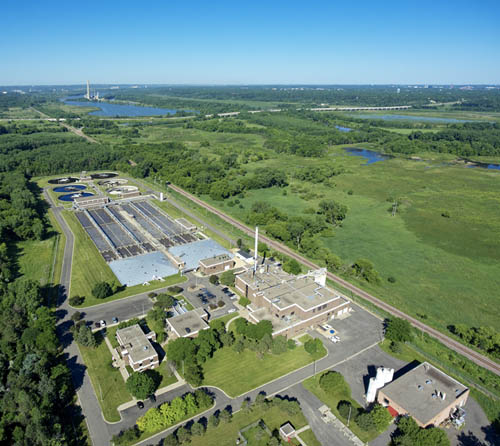
The new Minnesota Vikings headquarters and continued build-out of Central Park Commons, both in Eagan, are getting a lot of attention these days.
But humming along in the background day after day, providing a vital service to Eagan and surrounding communities, is the Seneca Wastewater Treatment Plant. This Metropolitan Council Environmental Services (MCES) facility also will be seeing its share of construction activity.
Over the next two years, MCES will make improvements at the Seneca Plant to preserve and renew aging equipment and facilities, increase energy efficiency, and help MCES operate the plant efficiently and cost-effectively into the future.
Expanding odor control capacity at Seneca Plant
Take the odor control equipment, for example, where odor removal efficiency has decreased since it was originally installed. A new odor control system will not just replace but will enhance the existing system, tripling the plant’s capacity to treat odorous air in wastewater solids processing. And that helps the plant in its quest to be a good neighbor.
“A lot has changed since the Seneca Plant opened in 1972, and this project is giving MCES an opportunity to maintain our ability to treat wastewater and improve our use of technology and efficiency,” said engineering project manager Jason Peterson, “as well as be more resilient for handling growth, weather events, and other environmental pressures.”
Other major components of the $19.2 million Seneca Plant Improvements Project
-
Upgrading the wastewater solids incineration exhaust system to meet new federal air emission limits.
-
Replacing solids thickening equipment.
-
Replacing the roof and safety railing on the Solids Processing Building.
-
Replacing lighting, aeration equipment, boilers, and solids processing equipment to decrease energy use (estimated $200,000 annual energy savings).
-
Repairing deteriorated concrete and installing a liner in primary wastewater treatment facilities.
-
Reconfiguring a plant building for additional maintenance work areas and equipment storage.
“At the Seneca Plant, environmental stewardship is the cornerstone of our mission,” said plant manager Dave Gardner. “And although you may not know us or see us, providing efficient and cost-effective wastewater services is our commitment to you, our customer.”
Community solar garden to be added near Seneca Plant
Community solar gardens at
MCES wastewater treatment plants
- Empire (Empire Township) – 5 MW
- Blue Lake (Shakopee) – 3 MW
- Seneca (Eagan) – 1 MW
This spring and summer, just three blocks east of the treatment plant, the Seneca Community Solar Garden is being installed. The solar garden will produce just under 1 megawatt of electricity – the equivalent of powering about 164 homes. Subscribers to the solar garden currently include the cities of Eagan and Burnsville, Dakota County, MCES and Metro Transit.
MCES will install the solar garden on 4 acres of a 7-acre site where the Seneca Plant landfilled ash from its solids incinerator from the mid-1970s to the mid-1980s. MCES closed the landfill in 1986 and continues to do post-closure monitoring. MCES will lease the land to solar facility owner Cyprus Creek Renewables. Construction began in late May and will take approximately three to four months to complete.
The Seneca Plant treats wastewater for approximately 250,000 people in the cities of Eagan, Bloomington, Burnsville and Savage, and small portions of Lakeville, Apple Valley, Inver Grove Heights and Edina. The plant treats approximately 22 million gallons of wastewater daily and discharges the resulting clean water to the Minnesota River.
More information